In their book Going by the Book from 1981, Bardach and Kagan explore the problem of regulatory unreasonableness and its characteristics and consequences. In this essay, the author will demonstrate what the authors mean with regulatory unreasonableness, explain the three different ways in which a regulation can be unreasonable, explain why the authors argue that some measure of unreasonableness is inevitable in any regulatory system and give a conclusion from today’s perspective.
Inhaltsverzeichnis (Table of Contents)
- Introduction
- Bardach and Kagan's idea of unreasonable regulation
- Lack of effectiveness
- Lack of efficiency
- Lack of a positive cost-benefit ratio
- The inevitability of regulatory unreasonableness
- Conclusion
Zielsetzung und Themenschwerpunkte (Objectives and Key Themes)
This essay examines the concept of regulatory unreasonableness as defined by Bardach and Kagan, exploring the different ways in which a regulation can be deemed unreasonable. It further investigates the inevitability of unreasonableness in any regulatory system and provides a modern perspective on this issue.
- Understanding the concept of regulatory unreasonableness as defined by Bardach and Kagan.
- Analyzing the three different types of unreasonable regulations: lack of effectiveness, lack of efficiency, and lack of positive cost-benefit ratio.
- Examining the reasons why unreasonableness is inevitable in any regulatory system.
- Exploring the social and political implications of regulatory unreasonableness.
- Providing a contemporary assessment of the relevance of Bardach and Kagan's work on regulatory unreasonableness.
Zusammenfassung der Kapitel (Chapter Summaries)
- Introduction: This chapter introduces the concept of regulatory unreasonableness and outlines the essay's objectives, drawing on the work of Bardach and Kagan.
- Bardach and Kagan's idea of unreasonable regulation: This chapter delves into the authors' definition of regulatory unreasonableness, highlighting their focus on cost-effectiveness. It distinguishes between rule-level and site-level unreasonableness, emphasizing the social dimension of the issue and the importance of site-level unreasonableness.
- The inevitability of regulatory unreasonableness: This chapter explores the reasons why unreasonableness is inherent in any regulatory system. It discusses the tension between the diverse world and general rules, the limitations of foresight in regulation, and the inherent conflict between equal treatment and diversity.
Schlüsselwörter (Keywords)
This essay focuses on the concepts of regulatory unreasonableness, cost-effectiveness, rule-level unreasonableness, site-level unreasonableness, effectiveness, efficiency, cost-benefit ratio, and the inevitability of unreasonableness in any regulatory system. It further explores the implications of regulatory unreasonableness for societal trust in the regulatory system.
- Quote paper
- Simon Valentin (Author), 2018, Regulatory Unreasonableness.What Is It and Why Is Some Measure of Unreasonableness Inevitable In Any Regulatory System?, Munich, GRIN Verlag, https://www.grin.com/document/491917



